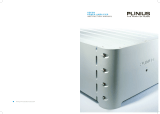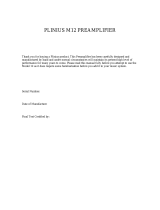Page is loading ...

The heart of music
www.pliniusaudio.com
SA-103
Power Amplifier
Instruction Manual


1
CONTENTS
Introduction 2
Design Philosophy 3
Unpacking 4
Placement & Ventilation 4
Precautions 5
Amplifier Features – Front Panel 6
Amplifier Features – Rear Panel 8
Installation and Operation 11
SA-103 Features 16
Loudspeaker Selection 18
Specifications 19
Index 20
All operational, technical and descriptive material in this publication
is subject to change at any time without notice. For further product
information or queries, please contact your PLINIUS dealer.
PLINIUS products are designed and manufactured by
Plinius Audio Limited, New Zealand.
www.pliniusaudio.com

2
INTRODUCTION
CONGRATULATIONS on your decision to become the proud owner of this
PLINIUS SA-103 Power Amplifier.
This manual has been prepared to help you understand the operation of your amplier,
and to provide information about its design and the variety of ways it may be used.
We have designed and manufactured this amplier to reproduce faithfully and
accurately, your favourite music. With a little care and a full understanding of the
operating recommendations in this manual, your PLINIUS SA-103 Power Amplier will
provide years of high-quality, trouble-free performance.
SERIAL NUMBER
FINAL TEST CERTIFIED BY
IMPORTANT: PLEASE TAKE THE TIME TO READ THIS MANUAL
THOROUGHLY BEFORE USING YOUR AMPLIFIER.

3
DESIGN PHILOSOPHY
From a distance you can see that the design of the Plinius products is more than
an applied styling exercise to the front panel. We have started from the ground up
to produce a casing for our electronics that is unrivalled in its physical strength and
visual simplicity.
Wherever possible we have reduced the number of parts needed and then invested
massively in refining and producing the remaining parts to the highest quality
achievable with state of the art computer controlled machines allied with expert
craftsman. Examples of this approach include the hydraulically formed corners on
the amplifiers giving much greater strength and the one piece housing for the remote
control that looks, feels and genuinely is robust.
As with music that you are not familiar with, truly innovative new designs can take time
to understand and enjoy. How often have you heard music that you were first unsure
of, that over repeated listening, has become a firm favourite?
Our designs are fundamentally different to many other companies, and we hope that
you will take the time to explore their unique character and qualities because we
have not made them different simply to be different. We genuinely believe that their
visual and tactile qualities do improve the experience of listening to music and that
is our design goal!
Ross Stevens
DESIGN DIRECTOR.

4
UNPACKING
Open the box from the top and remove the accessories from the top foam cap. You
may now proceed with the removal of the top foam cap. Once you have removed the
top foam cap you may now proceed to lift the unit from the box, You will require help
with this, as this unit is very heavy.
We suggest retaining the packaging for future transportation of the SA-103.
PLACEMENT & VENTILATION
Your PLINIUS SA-103 may operate at a moderately high temperature, especially
during extended listening sessions. The ideal location is upon a rigid stand, or floor
mounted away from direct contact with any temperature sensitive materials, furniture
or deep pile carpets. Ventilation through and around the amplifier should also be
kept unimpeded. Please ensure that the heat vents (slots in the lid and base) and the
heatsink fins on either side are not covered or restricted in any way.
The PLINIUS SA-103 design incorporates a very high level of mechanical decoupling
of the input and output. It can however still be influenced by acoustical feedback in
the operating environment. The use of acoustic cones or a suitably spiked amplifier
stand or table may further enhance the performance of this amplifier. Consult your
Plinius dealer for further advice if required.

5
PRECAUTIONS
PLEASE TAKE SPECIAL NOTE OF THE FOLLOWING PRECAUTIONS BEFORE
OPERATING YOUR NEW AMPLIFIER.
The PLINIUS SA-103 Power Amplier can be operated in mono mode delivering up to 460
watts into 8 ohms. This amplier is also capable of a very large peak current delivery.
The PLINIUS SA-103 Power Amplier operates in Class A. It is capable of generating
temperatures that could have an adverse effect on other equipment, furniture etc.
DO NOT leave ammable material on the amplier whilst running, as this could pose a
serious re risk.
The PLINIUS SA-103 Power Amplier is of direct-coupled design, and offers no protection
from preampliers that have a high DC component at their outputs.
This amplier operates at hazardous voltage levels. Any work requiring removal of the
lid or base of this amplier must be referred to a suitably qualied and experienced
service technician.
DO NOT attempt to connect any input of this amplier to it’s own outputs.
DO NOT earth any output terminal or connect any of these terminals together without
following the instructions in this manual or seeking qualied assistance.
DO NOT place this amplier in any position where liquids or any foreign material may
accidentally enter it.
DO NOT connect any voltage source, short circuit, earth/ground or appliance (other
than suitable high delity loudspeakers) to the amplier output terminals.
Some preampliers, processors, CD players’ etc. produce large switching pulses when
switched on causing a loud click through the loudspeakers. For this reason, turn on all
other equipment in your system before turning on your PLINIUS SA-103, or ensure that the
amplier is in MUTE. You will not experience this phenomenon with Plinius preampliers.

6
AMPLIFIER FEATURES
– FRONT PANEL
ABOVE: SA-103 front panel layout
Power LeD
An LED in the centre of the front panel indicates the power is on. When first switched
on, the display will vary in brightness until the initialisation sequence is completed,
after which the LED remains lit.
MUTe SwITCH
It is not recommended practice to interfere with the input cables while the amplifier
is switched on and connected to the loudspeakers, so a Mute button is fitted to
interrupt the input signal. This allows you to connect and disconnect the input cables
without the necessity of turning the amplifier off.
When the amplifier powers up from start, it will automatically go into Mute and
disconnect the speaker outputs. In this mode the Mute LED is ON. Press the Mute
switch to take the unit out of Mute and begin listening.
CLASS A SwITCH
This switch on the right of the panel alters the operating bias of the amplifier. Press
once to activate Class A, and again for Class AB. In Class A the LED is ON. Either
mode may be used for listening, with Class A preferred.
CLASS AB: This position reduces the bias on the output stage to operate the
amplifier in Class AB. This is a bias configuration used by the majority of high
fidelity amplifiers. In Class AB your PLINIUS SA-103 produces very high quality sound,
suitable for all occasions where critical listening is not a priority. A dual benefit exists

7
in that this facility provides the user with a much cooler operating temperature, and
a much reduced demand on the mains electricity supply, particularly at idle while
the amplifier is not reproducing music. This feature allows you to leave the PLINIUS
SA-103 switched ON at all times, rendering the amplifier ready for use and requiring
only a few minutes of warm-up in Class A before the very best of the amplifier’s sonic
qualities may be experienced.
CLASS A: This position provides Class A bias to the output stage therefore ensuring
the optimum performance of the amplifier during all listening events. Class A
amplifiers run hotter than Class AB amplifiers, hence our specially designed and
distinctive heat sinks. Operating the amplifier in Class A necessitates two precautions
that should be observed.
1. On switching to Class A, the temperature of the amplifier will quickly increase
and the amplifier will become quite hot. Ensure that you have left adequate
space around the amplifier for ventilation.
2. The power required from the mains supply in Class A is approximately 500
watts, similar to a small electric heater. The amplifier should not be connected
to a wall outlet that is shared with other heavy current appliances such as
heaters or electric motors. If in doubt, check with your Plinius dealer for advice.
wHY CLASS A IS BeTTer
Class A has always been regarded as the perfect operating mode for audio amplifiers.
Many leading amplifier designers and manufacturers world wide recognise that a well
designed Class A circuit has inherently lower distortion than any other design.
Class A circuit topology is one in which the total current the amplier is capable of
delivering, is kept owing in the circuit regardless of demand. In a conventional or Class
AB amplier circuit this current ow varies when demand varies. Furthermore, as current
varies, the voltage on the power supply rails (as seen by the output stage) varies too.
In a Class A circuit, current draw should be constant therefore there is an absence of
the power supply modulation common in Class AB design ampliers. Pinpoint images,
tonal clarication, intertransient silence, more readily dened dynamic shadings, inner
detail and authority are all inherent advantages of good Class A design.

8
AMPLIFIER FEATURES
– REAR PANEL
This panel incorporates all the terminals for connecting the input signals from your
preamplifier, and output to the loudspeakers, and mains supply. A reasonable
understanding of this amplifier’s operation and a logical approach should ensure that
you are able to make all connections with ease.
ABOVE: SA-103 rear panel layout
INPUT TerMINALS
Input terminals for your PLINIUS SA-103 Power Amplifier are easily accessible and fitted
near the top centre area of the rear panel.
RCA INPUTS: These standard RCA terminals are for use with unbalanced signals from
most signal sources such as audio preamplifiers.
XLR BALANCED INPUTS: XLR connectors fitted to this amplifier are for use with
balanced line signals from audio preamplifiers. Balanced signals are carried via a
three way cable that connects all three pins at each end of the interconnect cable.

9
The XLR input pin configuration used in all Plinius products is as follows:
PIN 1 to GND
PIN 2 to +Signal
PIN 3 to -Signal
NOTE: Because of the way balanced XLR inputs are configured it is not possible to
connect both XLR and RCA at the same time.
AMPLIFIer CoNFIGUrATIoN SeLeCTor (ACS)
The Amplifier Configuration Selector (ACS) is a unique switching method that exploits
all of the operational features of your PLINIUS SA-103 Power Amplifier. By using this
switch it is possible to operate your amplifier with either balanced or unbalanced
signals and achieve a stereo or mono output.
The ACS switch options are:
RCA STEREO: This option provides a stereo output via both left and right output
channels from a stereo signal connected to both left and right input RCA inputs.
RCA BRIDGED MONO: This option configures your amplifier to drive one loudspeaker
from one unbalanced signal fed to the RIGHT RCA input.
XLR STEREO: This option provides a stereo output signal from a balanced stereo
input signal connected to both the left and right XLR inputs.
XLR BALANCED MONO: In this mode both channels of your PLINIUS SA-103 combine
to operate as a true balanced mono amplifier, from input to output. This configuration
provides the highest quality mono performance from a balanced line input connected
to the RIGHT BALANCED XLR INPUT.

10
BALANCeD/UNBALANCeD SIGNALS
Balanced or unbalanced input options will depend on the type of signal available
from your preamplifier or other equipment. The PLINIUS SA-103 provides both options
to allow you to choose the most suitable preamplifier for your purposes. Plinius
preamplifiers offer both balanced and unbalanced output options.
BALANCED LINE is normally used to transmit signals in a professional environment.
Because balanced line effectively reduces or eliminates noise pick-up by the system
cabling, it has become increasingly more important in high-quality domestic high
fidelity systems.
UNBALANCED leads such as single ended, RCA or coaxial are common and are
used in the majority of audio signal systems. The terminal plug and socket are
most commonly called RCA and can be found on your PLINIUS SA-103 for use as the
standard input terminals for both left and right inputs.
oUTPUT TerMINALS
Output connections for the loudspeakers are provided on the left and right hand side
of the rear panel. Two parallel pairs of binding posts for each channel are tted – these
provide ease of use with bi-wiring and multiple cables requiring a large contact area.
MAINS SwITCH
This heavy-duty rocker switch in the centre of the panel turns the Mains/Line Power to the
amplier ON or OFF. An LED in the centre of the front panel indicates that the power is
on. When rst switched on the power LED will vary in brightness for ten seconds – this
is an initialisation sequence, after which the power LED remains lit. The amplier draws
a moderately high current when switched on. Despite the “Soft Start Circuit” within the
amplier reducing current demand on the mains as the amplier is switched on, it is not
good practice to rapidly turn the Mains switch on and off repeatedly.
reMoTe TrIGGer TerMINALS
In order to integrate more effectively into a home theatre or multimedia system, the
PLINIUS SA-103 has remote trigger terminals fitted to the rear panel. By connecting
a processor with a remote trigger signal to these terminals, the SA-103 can be put in
and out of Class AB/mute by the processor to which it is connected. When in Class
AB/mute the amplifier draws less current and will operate at minimum temperature.
The output relays are also open, disconnecting the loudspeakers. This may be of
advantage in a multi-amplifier and/or remote installations. Polarity of the connections
to the remote trigger is not important.

11
GroUND LIFT SwITCH
This switch is located adjacent to the Mains Input Socket, and allows the signal
ground to be disconnected from the chassis. In some installations a hum loop
may exist due to duplicate ground paths from different equipment. Use this switch
to remove the connection from 0V to ground thus allowing some flexibility in your
particular set-up. Note that when using Balanced XLR inputs, the ground lift switch
should always be set to ‘chassis’.
MAINS Power CorD IeC CoNNeCTor
This connector is where the mains supply cable from your wall connects to the
amplifier. You will notice that a fuse holder is mounted within this connection, and it
holds a mains fuse to provide surge and overload protection for your amplifier.
INSTALLATION AND
OPERATION
wArNING: rISK oF eLeCTrIC SHoCK
This amplifier operates at hazardous voltage levels. We recommend that any work
requiring removal of the lid be referred to a suitably qualified and experienced service
technician. DO NOT place this amplifier in any position where liquids or any foreign
material may accidentally enter it.
CAUTIoN!
PLEASE READ AND UNDERSTAND THE PRECAUTIONS IN THE INSTRUCTION MANUAL
FOR THE POSITION AND OPERATION OF YOUR PLINIUS AMPLIFIER.
CoNNeCTIoN
Connections to your PLINIUS SA-103 should be made in the same order as they are
listed in this section. DO NOT attempt to connect your PLINIUS SA-103 until you have
read and fully understood these instructions.
Although these instructions refer to the connection of a preamplier, the SA-103 can also
be safely installed into multimedia systems by following the same installation guidelines.
Should you require any further assistance, please contact your Plinius dealer.

12
ABOVE: Rear panel layout showing input and output terminals
PreAMPLIFer INPUTS
Connect your preamplifier to the input of the PLINIUS SA-103 using suitable single-
ended RCA or Balanced XLR interconnect cables only.
If using single-ended RCA inputs, connect your preamplifier to the RCA inputs on the
back of the PLINIUS SA-103. Make sure you connect the red coded cable to the red
RIGHT RCA input, and the black (or white) cable to the black LEFT RCA input. Also
make sure the RCA connectors are a snug fit and are inserted all the way in. For XLR
input connection, make sure you connect the RIGHT XLR input and LEFT XLR inputs
to the right and left outputs from your preamplifier respectively.
Use the Amplier Conguration Selector switch to select RCA STEREO if you are using
unbalanced RCA inputs or to select XLR STEREO if you are using balanced XLR inputs.
Preamplifier Output Interconnects SA-103 Input
NOTE: DO NOT connect XLR and RCA at the same time, use only one or the other.
Detailed instructions for using the SA-103 in RCA BRIDGED MONO, and XLR BALANCED
MONO modes are later in this section.

13
LoUDSPeAKer oUTPUTS
The connection of your loudspeakers to the output posts of the PLINIUS SA-103 must
be made by an ‘instructed person’ or by ready made loudspeaker cables only.
Connect your left loudspeaker (ie. the one on your left when seated in your normal
listening position) to the left output terminals, ensuring that the red positive (+) terminal
on the amplier is connected to the red positive (+) terminal on your loudspeaker. Do the
same with the black or negative (-) terminals. Repeat this process for the right outputs
SA-103 Output Speaker Cables Speaker
TerMINATIoN QUALITY
Quality of the connections must be examined to ensure that high performance
trouble free operation is enjoyed. Check that the connections are tight but do not
over tighten. If bare wires are used make sure that no loose strands of wire short
cross the other terminals or the amplifier chassis. When using plugs such as
bananas, be sure to use good quality plugs with a firm fit.
BI-wIrING
Bi-wiring uses two pairs of loudspeaker cables for each channel loudspeaker. You will
notice that the rear panel of your PLINIUS SA-103 has two pairs of output terminals for
this purpose. Be sure to follow correct practises for stereo and mono configurations
when using bi-wiring.
PHASING (or PoLArITY)
It is important to achieve good stereo imaging in your listening room. By observing
the wiring instructions above, each Power Amplifier/loudspeaker combination should
be in phase. If you experience poor stereo image and/or a lack of bass, check that
the loudspeaker wiring has been connected correctly. We recommend that you use

14
one of the easily obtainable ‘test discs’ to help you ensure both phasing and channel
orientation are correct. If in doubt, consult your Plinius dealer for advice.
To achieve a sound performance that is correctly aligned to your room, make sure all
of the leads carrying signals for the right channel loudspeaker are connected to the
right input to the amplifier from your preamplifier
BrIDGeD/MoNo CoNNeCTIoNS
There are essentially four different ways that you can connect your system
components to the PLINIUS SA-103 Power Amplifier:
1. RCA STEREO
2. RCA BRIDGED MONO
3. XLR STEREO
4. XLR BALANCED MONO
The following section explains how to use the SA-103 in RCA Bridged Mono and XLR
Balanced Mono configurations.
rCA BrIDGeD MoNo
This option configures your amplifier to drive one loudspeaker from one unbalanced
signal fed to the red RIGHT RCA input. In bridged mono mode the only input made
to your preamplifier is to the red RIGHT channel RCA input. The black LEFT channel
RCA input is not connected.
Next your loudspeakers are connected to both positive (+) channel output terminals.
So the positive red connection on your loudspeaker is connected to the red RIGHT
amplifier output, and the negative black connection on the loudspeaker should be
connected to the red LEFT amplifier output.
DO NOT CONNECT ANYTHING TO THE NEGATIVE (-) TERMINALS. MAKING A
CONNECTION TO THE NEGATIVE (-) TERMINALS OF THE AMPLIFIER IN THIS MODE
CAN CAUSE SERIOUS DAMAGE!
You can still connect two loudspeakers using the lower positive (+) amplifier output
terminals. This is explained in the bi-wiring section previous.
Now turn the ACS switch fully clockwise then one position counter-clockwise so that it
is in the RCA Bridged Mono position.

15
XLr BALANCeD MoNo
As with RCA Bridged Mono, this option configures your amplifier to drive one
loudspeaker, but from one balanced line input connected to the RIGHT XLR Input.
In balanced mono mode the only input made to your preamplifier is to the RIGHT
channel XLR input. The LEFT channel XLR input is not connected.
Next your loudspeakers are connected to both positive (+) channel output terminals.
So the positive red connection on your loudspeaker is connected to the red RIGHT
amplifier output, and the negative black connection on the loudspeaker should be
connected to the red LEFT amplifier output.
DO NOT CONNECT ANYTHING TO THE NEGATIVE (-) TERMINALS. MAKING A
CONNECTION TO THE NEGATIVE (-) TERMINALS OF THE AMPLIFIER IN THIS MODE
CAN CAUSE SERIOUS DAMAGE!
You can still connect two loudspeakers using the lower positive (+) amplifier output
terminals. This is explained in the bi-wiring section previous.
Now turn the ACS switch fully counter-clockwise so that it is in the XLR Balanced
Mono position.
CoNNeCTING THe MAINS SUPPLY
Firstly, check that the mains supply voltage printed on the rear of this amplifier is
similar to the mains supply voltage in your area. If in doubt, please consult your
Plinius dealer. Mains supply power connection is via the plug-in lead supplied with
your PLINIUS SA-103.
Check the wall outlet is switched OFF, then connect the local mains plug end of the
lead to the wall outlet. Check the SA-103 is switched OFF, and connect the IEC end of
the cable to the IEC socket at the back of the SA-103. With the cord fully connected,
switch the wall outlet ON. Now that your PLINIUS SA-103 is configured correctly, switch
the power switch on the rear panel to ON.
The display LED will cycle in brightness for approximately ten seconds as the internal
circuitry stabilises. Use the MUTE switch on the front panel to take the unit out of
MUTE and you can now enjoy your new PLINIUS SA-103 Power Amplifier.
NOTE: This unit must be connected to a mains socket outlet with a protective earthing
connection. The wall outlet socket or SA-103 mains switch must be accessible at all
times in case of emergency.

16
wArM-UP PerIoD
You will find that the PLINIUS SA-103 will become noticeably ‘purer’ in sound after
being on for a period of time. We recommend waiting at least 24 hours before
expecting the best quality of sound reproduction from your amplifier. We suggest
leaving the unit turned on so that it will always be at it’s sonic best.
SA-103 FEATURES
error DeTeCTIoN
The PLINIUS SA-103 Power Amplifier has in-built error detection. This will function
under the following conditions:
When the amplifier is overdriven/clipped, and
If any internal fuse is damaged.
Should either of these circumstances arise the amplifier will disconnect both
channels and mute the input. This condition will remain until the input signal level is
reduced or the damaged fuse replaced. When error detection is triggered the power
LED will turn off and the mute LED will pulse. The internal error LED (located towards
the front of the circuit board in the top cavity of the amplifier) will also light.
FUSe ProTeCTIoN
When any internal fuse is damaged one or more fuse warning LEDs will light. These
LEDs are under the amplifier lid located near the centre of the main circuit board
with the rail fuse holders. If any of the internal fuse LEDs are glowing ensure that
your amplifier is switched OFF and disconnected from the mains supply. The lid of
the amplifier will need to be removed and the fuse adjacent to the lit LED should be
replaced. Replace them with the same type only.
IMPORTANT: DO NOT FIT A FUSE WITH A HIGHER RATING.
NOTE: that fuse failure may indicate a severe problem. Check all speakers and
speaker cables for damage etc. Should the amplifier continue to exhibit rail fuse
failure, contact your Plinius dealer.

17
eCoLoGIC CoNTroL
The PLINIUS SA-103 is also fitted with a microprocessor which monitors and performs
the Bias and Mute functions. It is programmed to switch the amplifier back into Class
AB if no signal has been present at the input for a predetermined time. This time can
be adjusted to Off, 15, 30 or 60 minutes. During the last minute without signal the bias
LED will pulse to indicate the unit is about to return to Class AB. The purpose of this
function is to prevent the amplifier being left in Class A while unattended for a long
period of time.
Before adjusting this time constant, ensure that your amplifier is switched OFF and
disconnected from the mains supply. Remove the amplifier lid and locate the small
jumper JP5 on the main circuit board at the front left. Adjustments are then made by
shifting the jumper to the appropriately labelled pins. The factory setting is 30 minutes.
MAINS/LINe FUSe
A Mains/Line fuse is fitted within the IEC Mains/Line socket on the rear of the amplifier.
A small drawer at the bottom of this socket may be removed (after the IEC plug is
removed) by levering it out with a flat blade screwdriver. The fuse fitted should be
rated as specified on the rear panel.
In the unusual event that this fuse should blow, you must first establish the cause of
this failure (such as power surges, damaged mains cable etc.) before replacing the
fuse with one of the same rating and type.
IMPORTANT: DO NOT FIT A FUSE WITH A HIGHER RATING.
NOTE: Fuse failure may indicate a severe problem. Should the amplifier continue to
exhibit mains fuse failure contact your Plinius dealer.
Ecologic Jumper JP5 Error LED

18
LOUDSPEAKER SELECTION
Your PLINIUS SA-103 Power Amplier is designed for use with high delity loudspeakers. It
should not be used to operate any other type of appliance or equipment.
Choice of loudspeakers is one of personal taste, providing the chosen loudspeakers
are suitable for use with your amplier. Be certain that your loudspeakers can handle
most of the rated output power of this amplier. You may nd loudspeaker specications
confusing or misleading so you should discuss this with your audio dealer prior to
purchase. As a general rule, the use of high power (200 watt RMS or greater) loudspeakers
is recommended and desirable. However, our experience indicates that medium to low
power loudspeakers (100 to 200 watt RMS) are quite often suitable for use with this amplier
provided the volume is maintained at a level where no distortion is audible.
Impedance of the loudspeaker load is important to ensure the rated performance of
this amplier. Any combination of loudspeakers may be used but the total average
impedance load for each channel should be within a range of 4 to 8 ohms. Again, if you
have doubts about the impedance of your loudspeaker conguration, we recommend
you speak to your Plinius dealer.
/
















